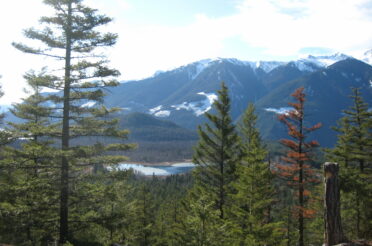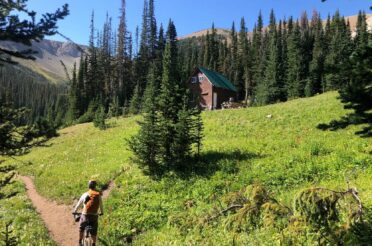
We already had two great days and were able to spot a Grizzly mum with a cub, which our guests wanted to see. We watched them from a safe distance playing in the snow. I knew that the 3rd day of our Wildlife Pack trip in Eldorado was going to be something extraordinary. The day started dramatically when we realized that one of our horses was gone. While the other guides went out to look for him, I took our guests over to the next valley where we were going to meet Kevan and three interns.
Our goal was to find the Mountain Goat (Oreamnos americanus) herd of Eldorado and count the nannies, yearlings and kids to measure the recruitment. Monitoring the recruitment and mortality is important to inform appropriate wildlife management actions and gives an idea about the actual population size and the future development and stability. As “British Columbia is the heartland of Mountain Goats and contains more than half of the world`s population” (Ministry of Environment, Land and Parks, 2000) we have the responsibility to protect the species to our best knowledge and ability. The Mountain Goat is on the blue B.C. List, which means that it is a species of special concern and is “sensitive or vulnerable to human activities or natural events” (BC Species and Ecosystem Explorer, Ministry of Environment, 2019). The Wilderness Stewardship Foundation (WSF) collected data (population monitoring, DNA collection, data acquisition) of the herds habituating in the Bridge River Watershed over the last 28 years to contribute to the improvement of the status (Wilderness Stewardship Foundation website, 2019). WSF`s conservation aim is to increase wildlife populations to the carrying capacities of the ecosystems. The Eldorado Mountain area is considered excellent habitat for goats (BC Parks website, 2019).
All together we crossed creeks and meadows full of green and juicy grass on the way to the top of the mountains, as the steep and rocky terrain above the treeline is the goat`s habitat, to which they are very well adapted. The species is a relic of the ice age and its disproportionate huge, muscular forequarters and specialized hoofs support it climbing steep and rocky slopes or on snow and ice (Ministry of Environment, Land and Parks, 2000). Riding along the slope we came to a challenging part that would take us up to the first ridge, this part did not look very welcoming, but rugged and steep. Kevan rode up first and everyone waited. Everyone rode up separately, when my turn came I was concerned and excited, not for the last time this day, but all went well. This day made me think in a different way of these amazing horses we have at the ranch, who are willing to take us everywhere. Their abilities are far more than I would have ever expected from horses.
Following under the ridge line, so that the Goats would not see us before we could see them and hide, we made our way glassing the mountains. As the Goats not only have one of the “thickest and longest pelage of any North American ungulate” (Ministry of Environment, Land and Parks, 2000), but also a completely white coat, it is easy to spot them in the summer. The color is an indicator for the evolution of the species in regions of snow and ice. The first individual we found was probably only 15 m away. The seven of us lying on the ridge line observing it and this beautiful creation was not scared of us at all. It almost seems like it was making a show for us, stepping up on the rocks, presenting every angle of its hairy body. Due to the goat’s behavior – alone and not accompanied by a kid or a yearling – we first came to the conclusion it must be a male (billy). Female goats rather live in a group with their offspring. Both sexes have horns that never shed with growth rings to indicate age. The difference is that the horns of the males show a gradual curve, whereas the horns of nannies are sharp, curved near the end. Further a female goat has small horn bases and a wider space in between of those (Ministry of Environment, Land and Parks, 2000). Having a closer look on the thin, black horns which can be up to 30 cm long, we discovered the lone goat was in fact a nanny.
Riding our trusty horses along the ridges we were not able to spot the herd, but found hair and bones of a goat that appeared to have been killed by a wolf just a few days ago. This explained why we could not find the herd. They were disturbed by a predator, which can be a wolf, grizzly, bird of prey or wild cat. Threats can have a direct impact on the population or on their habitat (Mountain Goat Management Team, 2010: p.22). Secondary threats often affect the habitat effectiveness, meaning the quality, quantity, suitability or function of the species habitat. This can be forest removal due to logging activities or fire suppression, which decreases their winter forage. Road construction for tourism or other industrial reasons can cause direct habitat loss or fragmentation. The subsequent isolation of herds or disconnection/reduction of habitat results in reduction of fitness and therefore less reproduction and increased predation (Mountain Goat Management Team, 2010: p.23). Conservation areas often prohibit such activities. The habitat of the Mountain Goats is within the South Chilcotin Mountain Park, which decreases the likeliness of industrial habitat threats. Other existing influences like recreational activities are more likely to occur though. These can also affect the population directly. Disturbance can be caused by different users and have a short or long term impact. The “Management Plan for the Mountain Goat (Oreamnus americanus) in British Columbia” (Mountain Goat Management Team, 2010: p. 27) implies a high reaction of Mountain Goats due to sensitivity to sudden and loud noises. A short term reaction can be running away as a response to a disturbance, whereas the long term response is displacement from habitat. The type of access and approach (e.g. walking, horseback, mountain bike, motorized or aircraft) have different effects, a common conclusion is the necessity of responsible regulated recreational use. A further threat is climate change. Although not well investigated yet, climate change will very likely affect the fragile ecosystems that are home to the species in the future (Mountain Goat Management Team, 2010: p. 30f.).
With this little foray to the conservation issues of the species, you might understand the importance of this day for me a bit better. I had the opportunity to ride on the mountain tops and feel more connected to nature, glassing for and tracking the herd – for more than 12 hours. It was hot and exhausting. I felt like being on top of the world, but water is very limited up so high. The late afternoon came and we sent our guests with the interns back to camp. Kevan and me continued following the ridgeline, as we had already put so much effort into finding the herd. We continued following the ridgeline, discovering fresh scat and beds where the goats enjoyed the afternoon sun.
Due to the limited accessibility of goat habitat, we have knowledge gaps about the species. Still we knew all the variables like habitat, behavior and habits, but we had a hard time finding them. Nature is just unpredictable. To find the herd luck was necessary as well – and we were lucky. Standing on a rocky bluff staring in the wrong direction and just overwhelmed by the view, Kevan spotted the herd above a snow bank under another peak. They were still a 20 min ride away from us. By the time we came closer to them they passed over another peak and rested on a slope enjoying the last sunshine of the day. We counted 12 nannies, 9 yearlings, 12 kids and 2 single individuals of Mountain Goats. We did not spot all the goats residing in the area, but the next day a group of 35 grazed up on the slopes behind our camp. The take away from our survey is that last year’s recruitment rate is approximately 70 % which is good, given predators and severe winter impact. The pattern is that as the Goat population increases in one area to the carrying capacity the group will break up and disperse to other less populated areas to increase the populated areas.
Author: Lisa, Germany
Photocredits: Kristin Noack
Sources:
Ministry of Environment, Land and Parks. 2000. Mountain Goat in British Columbia, Ecology, Conservation and Management. http://www.env.gov.bc.ca/wld/documents/mtngoat.pdf
Ministry of Environment. Oct. 13th 2019, 09.30 am. BC Species and Ecosystem Explorer. http://a100.gov.bc.ca/pub/eswp/search.do;jsessionid=fQbFuDE8FvtOJpQ4diAb2Un01j3JM2-3zCebEmE5w9NEEy2AbzrK!1905302002
Mountain Goat Management Team. 2010. Management Plan for the Mountain Goat (Oreamnos americanus) in British Columbia. Prepared for the B.C. Ministry of Environment, Victoria, BC.
Wilderness Stewardship Foundation. Oct. 13th 2019, 11.47 am. Mountain Goat. https://wilderness.stewardship.foundation/mountain-goat/
BC Parks. Oct. 13th 2019, 11.45 am. South Chilcotin Mountains Provincial Park: Nature and Culture. https://www.env.gov.bc.ca/bcparks/explore/parkpgs/south_chilcotin_mts/nat_cul.html



